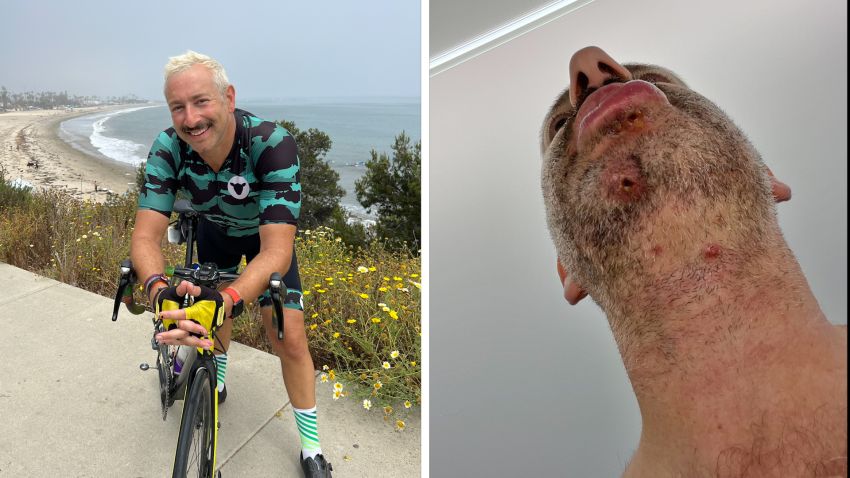
Monkeypox may spread before symptoms start, study suggests


Two doctors struggled to diagnose him. He had an early case of monkeypox
02:51 – Source: CNN
CNN —
More than half of monkeypox cases in the current outbreak may have been passed to others before symptoms appeared, according to a new modeling study from the United Kingdom.
The study, which was led by disease modelers at the UK Health Security Agency, is contrary to current public health guidance about how monkeypox spreads. It also has important implications for how to contain outbreaks of the infection, particularly those that spring up within sexual networks. The research is published in the medical journal The BMJ.
Bill Hanage, an epidemiologist with the Harvard T. H. Chan School of Public Health, says the new study gets to the heart of a question that public health officials have been trying to answer for months: How, exactly, is the virus spreading?
In countries where the virus routinely spreads, such as the Democratic Republic of Congo, most of those who get it are children living in rural hunting villages. Much of what we know about the virus comes from those settings, where transmission occurs in families living in close quarters. In countries now having outbreaks due to imported cases, nearly all of those infected are men having sex with other men, and routes of transmission have changed.
“The thing is with poxviruses in general, you tend to see transmission once symptoms develop,” said Hanage, who was not involved in the study. “For several months now, there’s been a concern, or sort of the increasing realization, that if you’re talking about transmission in sexual networks, if there’s any type of contact where pre-symptomatic transmission would be possible, that’s it.”
Hanage says transmission before people know they are infected helps to explain the explosive growth of the outbreak before vaccination became widespread. It also suggests that the virus is likely being passed through sex before a person has symptoms they’re aware of. Monkeypox virus has previously been detected in semen, and also in the anal swabs of infected men who didn’t have symptoms.
Before this study, doctors were aware it was possible to shed the virus before symptoms appeared, “but we didn’t know how common it was,” said Dr. John Swartzberg, an infectious disease specialist at the University of California at Berkeley School of Public Health.
Since May 2022, more than 75,000 monkeypox cases have been reported globally, with 99% of those in countries where the virus does not commonly spread, according to data from the US Centers for Disease Control and Prevention.
Monkeypox cases have dropped dramatically in the United States. As of October 26, the seven-day average of new monkeypox cases reported to the CDC stands at about 30 per day, down from a high of 446 cases per day in early August.
There have been 28,492 cases of monkeypox diagnosed in the US as of Wednesday, according to the CDC.
This progress indicates public health efforts to raise awareness of the infection and encourage vaccination of those at high risk are working.
But even as these efforts pay off, public health officials say it’s important to guard against complacency and misinformation about the disease to keep it from coming back.
Currently, official guidance states that people can transmit the infection only after they develop symptoms.
As of Wednesday, the CDC’s website, for example, advises readers that “A person with monkeypox can spread it to others from the time symptoms start until the rash has fully healed and a fresh layer of skin has formed.”
That guidance aligns with information from both the World Health Organization and the UK government about how monkeypox spreads.
But that’s not what epidemiologists found when they investigated contact tracing records from the current monkeypox outbreak in the UK. As in the US, about 95% of recent monkeypox cases in the UK have been among men who have sex with other men. Most cases have been reported after close sexual contact.
For the study, researchers culled records on 2,746 monkeypox cases in the UK identified from the start of their recent outbreak through August 1. From that larger set of records, they looked for cases with linked contacts where both people had infections that were confirmed by PCR tests and had recorded dates for the start of their symptoms.
They found 79 pairs of linked cases and contacts that had all the required information.
From these records, they were able to determine a metric called the serial interval, which is roughly the time between the start of symptoms in a case to the start of symptoms in the person they infected.
From a separate subset of 54 people who filled out questionnaires, researchers were able to pinpoint when they were exposed and when their symptoms first began to calculate the incubation period for the infection – how long it takes for symptoms to develop after an exposure.
They found that the incubation period was sometimes longer than the window between the start of symptoms in a case and their linked contact – a pattern that’s explained when transmission occurs ahead of symptoms.
Overall, after researchers adjusted their data to account for possible sources of bias, they found the median serial interval between cases and contacts in the study was shorter than the median incubation period for infections, “which indicates considerably greater pre-symptomatic transmission than previously thought,” the study authors write.
CNN reached out to the CDC with questions about whether the study might change its guidance on monkeypox, but didn’t receive a reply by deadline. The CDC doesn’t typically comment on research it is not involved in, and public health agencies don’t normally change their advice on the basis of a single study.
The researchers estimate that based on their data, more than half (53%) of transmission in the UK outbreak occurred in this pre-symptomatic phase of the infections.
In the study, researchers found transmission occurred up to four days before a person got their first symptoms – typically a headache, fever, swollen lymph nodes, muscle aches and a rash. Proctitis, a painful swelling of the lining of the rectum, can also occur.
“I think that it should change the messaging,” said Hanage. “I think that the messaging should be that if you were worried about monkeypox, you cannot assume that your partner is not infectious just because they don’t have symptoms.”
If they’re vaccinated, that’s a different story, Hanage said, though it’s not yet known how effective the vaccines have been at preventing infections.
Early in the summer, when vaccine supplies were scarce, public health officials were limiting vaccinations to the known contacts of people with diagnosed with monkeypox, a strategy which likely allowed continued growth of the outbreak because of pre-symptomatic spread, said Swartzberg, who was not involved in the study.
Since vaccine doses have become more plentiful, both the US and UK have switched to vaccinating people at high risk for catching the infection, which was the right strategy to curtail asymptomatic spread, Swartzberg said.
“There is sufficient data now, that shows that monkeypox can also be spread by people with no symptoms and therefore anybody at risk for contracting monkeypox – whether or not they have symptoms – should do two things: One is get vaccinated if they haven’t been vaccinated, and two is take all necessary precautions to prevent transmitting this virus,” Swartzberg said.
Other experts say that although the research appears to be well done, it’s still just a single study and needs to be repeated by others, hopefully quickly.
“This needs confirmation by more studies but has implications for vaccination-based disease elimination strategies which should be seriously considered,” said Dr. Boghuma Kabisen Titanji, who is an infectious disease specialist at Emory University.
“What proportion of cases are asymptomatic and how much do these cases contribute to seeding new transmission chains? These are urgent questions that need answers,” Titanji told the nonprofit Science Media Centre, in a statement about the study.
Source: https://www.cnn.com/2022/11/02/health/monkeypox-spreads-before-symptoms/index.html
















